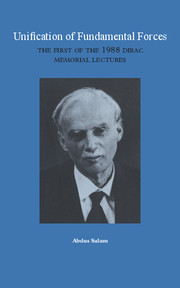Book contents
- Frontmatter
- Contents
- Foreword
- Unification of fundamental forces
- 1 Introduction
- 2 The unifying concepts of physics in the past
- 3 The concept of elementarity and nuclear forces
- 4 The unification of the weak nuclear force with electromagnetism
- 5 The strong nuclear force as a gauge force and the standard model
- 6 Beyond the standard model
- 7 Envoi
- History unfolding: an introduction to the two 1968 lectures by W. Heisenberg and P. A. M. Dirac
- Theory, criticism, and a philosophy
- Methods in theoretical physics
4 - The unification of the weak nuclear force with electromagnetism
Published online by Cambridge University Press: 08 January 2010
- Frontmatter
- Contents
- Foreword
- Unification of fundamental forces
- 1 Introduction
- 2 The unifying concepts of physics in the past
- 3 The concept of elementarity and nuclear forces
- 4 The unification of the weak nuclear force with electromagnetism
- 5 The strong nuclear force as a gauge force and the standard model
- 6 Beyond the standard model
- 7 Envoi
- History unfolding: an introduction to the two 1968 lectures by W. Heisenberg and P. A. M. Dirac
- Theory, criticism, and a philosophy
- Methods in theoretical physics
Summary
Forces produced by exchanges of messengers
The crucial idea that permitted our generation to unify electromagnetism and the weak nuclear forces (rather than electromagnetism and gravitation, as Faraday and Einstein wanted) was that both these forces (electromagnetism and the “weak” nuclear) have spin-one messengers and are “gauge” forces. (I shall define “gauge” forces presently.)
In quantum theory, all forces – whether of gauge or nongauge variety – are produced by an exchange of particles, which I shall call “messengers”. These “messengers” must always have integer intrinsic spins (0, 1ħ, 2ħ, etc.) as contrasted with the “source” particles of matter like electrons, neutrinos or protons and neutrons which are described by Dirac's equation and have intrinsic spins of ħ/2 each.
The fundamental property that characterises gauge forces (as opposed to nongauge forces) is that they are produced by an exchange of “messengers” of spin-one.
- Type
- Chapter
- Information
- Unification of Fundamental ForcesThe First 1988 Dirac Memorial Lecture, pp. 39 - 58Publisher: Cambridge University PressPrint publication year: 1990

